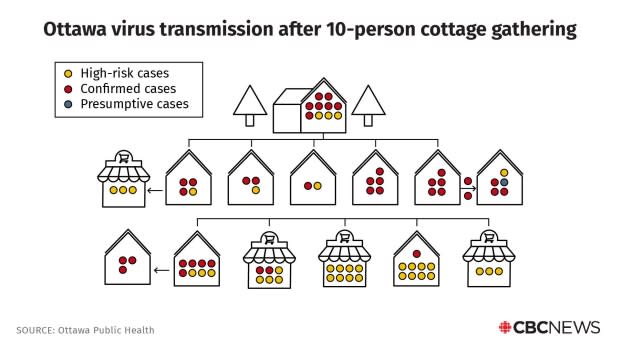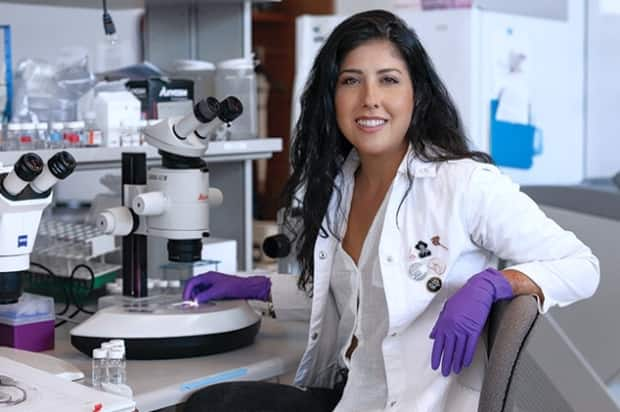It's easy to point the finger at parties — but younger Canadians spread COVID-19 in all kinds of settings

The virus behind COVID-19 has a knack for slithering through society undetected.
Not everyone gets a fever, and not everyone gets a cough. Instead, the range of symptoms can pop up in various parts of someone's body, like a nagging headache or upset stomach, mimicking a whole host of other ailments. Many people don't feel sick enough to worry, if they ever get symptoms at all.
So when someone young and healthy does test positive for SARS-CoV-2 — as hundreds of Canadians now do every day — the question often is: Where'd they catch it?
In Ontario, Premier Doug Ford often points the finger at crowded parties. "We can't have these big parties," he said earlier this month. "We can't have the big weddings."
There are multiple recent reports of cases tied to bustling indoor spaces — from strip clubs to wedding events — that build on months of research showing the combination of crowds, close contact and closed settings for virus transmission is like kindling for a fire.
But younger Canadians may also be fuelling the spread of COVID-19 in far more mundane ways, with potentially dire consequences.
Emerging details from public health officials suggest a variety of social gatherings are helping SARS-CoV-2 find new hosts — and in Ontario, a majority of those virus carriers are under 40.
They're getting infected at cottages, family gatherings, dinner parties — all kinds of indoor settings, and not always the ones with large, headline-making crowds.
"The vast majority of transmission is with close contact with someone who's infected, typically for a prolonged period of time in an indoor environment," said Dr. Isaac Bogoch, a Toronto-based infectious disease specialist.
Risks in indoor settings
The notion that indoor settings are riskier is nothing new. For months, case studies from around the world have highlighted danger zones: cruise ships, a call centre, a choir practice.
But the specifics of where real people are getting real infections in Ontario has been hazier, beyond now-obvious hot spots like long-term care homes and other institutional settings.
In recent weeks, a clearer picture began emerging.
On one end of the spectrum, there are the big, risky gatherings called out by Ford: A series of wedding events in Markham led to more than 20 cases, for example, while infected staff at two Toronto strip clubs sparked multiple confirmed cases and hundreds of possible exposures.
In London, Ont., at least nine university students have tested positive for the virus so far, and public health officials suggested they socialized in the city's jam-packed downtown bar scene.
WATCH | How to navigate daily challenges amid the COVID-19 pandemic:
Then there's the other end of the spectrum: smaller groups of friends and family meeting up indoors.
In Windsor, public health officials recently carried out contact tracing and tracked more than 30 recent cases back to one family's social life — including parties and dinners with friends at home and a card game in a storage unit, the region's local newspaper reported.
Toronto's medical officer of health, Dr. Eileen de Villa, on Monday outlined several similar settings that led to recent infections, including one family gathering and another family's trip where time was spent with someone who wound up having COVID-19.
"Personal gatherings are the main driver of cases," Dr. Mustafa Hirji, acting medical officer of health for Niagara Region, noted in a tweet the same day.
LISTEN | Helping Canadians under 40 stay safe from COVID-19:
One striking case study from Ottawa involved a 10-person cottage trip. It's a gathering size allowed by the province, as long as there's physical distancing in place, but according to the city's medical officer of health, Dr. Vera Etches, the trip wound up being a cautionary tale.
"There was one person who developed cold-like symptoms while at the cottage party and then tested positive on their return home. Subsequently, seven of those friends tested positive for COVID-19," Etches recently told Ottawa's city council.
"Within nine days, one person with symptoms became 40 confirmed people who tested positive."
After leaving the cottage, some members of the group had visited work and retail locations, including two child-care centres that wound up shuttered to prevent further spread — and several people ended up hospitalized.

'It leaves lasting damage'
That's the ripple effect of young adults getting infected: They can pass it on to more vulnerable people, including the elderly and those in long-term care, who are more likely to wind up seriously ill or worse.
Those younger Canadians themselves could also fare poorly, even if death is a rare outcome.
According to a random sample of hospital outpatients from the U.S. Centers for Disease Control and Prevention, 20 per cent of previously healthy adults between 18 and 34 weren't back to their usual health 14 to 21 days after testing positive, while thousands of others around the world say their symptoms are lasting far longer.

Nada Forbes, a 37-year-old mother of two living in Oakville, Ont., has been suffering with lingering symptoms for six months after testing positive for the virus following a trip to Egypt in March.
The illness started with chest pain, but Forbes never had a fever or cough, which are the usual symptoms. Instead, she wound up having various gastrointestinal issues and shortness of breath.
"You can get a moderate case, or a mild case, that goes on and on and on, and leaves lasting damage and leaves you with these lingering problems — when you started as a healthy person without any pre-existing conditions," she warned.
Don't 'shame and blame'
Months into the pandemic, health experts now say it's crucial the younger demographic is better informed about how to avoid spreading the virus, without any finger-pointing.
"Harm reduction is not about shame and blame," said Samantha Yammine, a Toronto-based neuroscientist and science communicator.
Yammine said for many young adults, avoiding risk can be difficult. She recently surveyed her roughly 70,000 Instagram followers about their COVID-19 experiences, and hundreds of respondents cited various challenges — from living with roommates or in a multi-generational home, to working in sectors where safety measures aren't always followed.
"Why did we ever open up indoor dining and have a setting where people would be talking loudly, with people in large groups, without wearing masks?" Yammine said.

The province is holding off on the next phase of reopenings, but there's no word yet if officials will start scaling back limits on the size of gatherings or implementing any lockdowns to curb rising case counts.
In the meantime, Bogoch said that for young adults trying to safely navigate daily choices, it's all about layering in protection to lower the risk as much as possible, such as increasing ventilation and wearing masks as much as possible.
"You want to get together for this wedding, for your friend's birthday, for some other ceremony, but let's make smart choices," he said. "So can you do it outside? Can you spread apart? Can you have fewer numbers?"
Yammine said the aim can't be zero risk, since that's an impossible goal.
"If we focus on what we can do versus what we can't do, we can empower people to make decisions that are more safe but allow them to live their lives," she said. "Because this isn't going away any time soon."

 Yahoo Movies
Yahoo Movies 